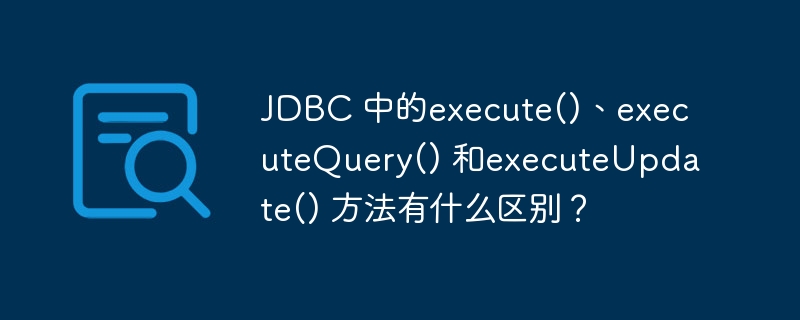

Une fois que vous avez créé un objet instruction, vous pouvez l'exécuter à l'aide de l'une des méthodesexecute(),executeUpdate() etexecuteQuery() de l'interface Statement.
Méthodeexecute() : Cette méthode est utilisée pour exécuter des instructions SQL DDL. Elle renvoie une valeur booléenne spécifiant si l'objet ResultSet peut être récupéré.
1 2 3 4 5 6 7 8 9 10 11 12 13 14 15 16 17 18 19 20 21 22 23 24 25 |
|
1 2 |
|
executeUpdate() : Cette méthode est utilisée pour exécuter des instructions d'insertion, de mise à jour, de suppression et d'autres. Il renvoie une valeur entière représentant le nombre de lignes affectées.
1 2 3 4 5 6 7 8 9 10 11 12 13 14 15 16 17 18 19 20 21 22 23 24 25 26 |
|
1 2 |
|
executeQuery() : Cette méthode est utilisée pour exécuter des instructions qui renvoient des données tabulaires (telles que select). Il renvoie un objet de la classe ResultSet.
1 2 3 4 5 6 7 8 9 10 11 12 13 14 15 16 17 18 19 20 21 22 23 24 25 26 27 |
|
1 2 3 4 5 |
|
Ce qui précède est le contenu détaillé de. pour plus d'informations, suivez d'autres articles connexes sur le site Web de PHP en chinois!
 Utilisation de base de l'instruction insert
Utilisation de base de l'instruction insert
 Comment utiliser le retour en langage C
Comment utiliser le retour en langage C
 Comment modifier element.style
Comment modifier element.style
 Comment lire les données d'un fichier Excel en python
Comment lire les données d'un fichier Excel en python
 Méthode de récupération de données informatiques Xiaomi
Méthode de récupération de données informatiques Xiaomi
 Comment entrer en mode sans échec sur un ordinateur portable
Comment entrer en mode sans échec sur un ordinateur portable
 Comment supprimer un index dans MySQL
Comment supprimer un index dans MySQL
 Python concernant l'utilisation du module
Python concernant l'utilisation du module